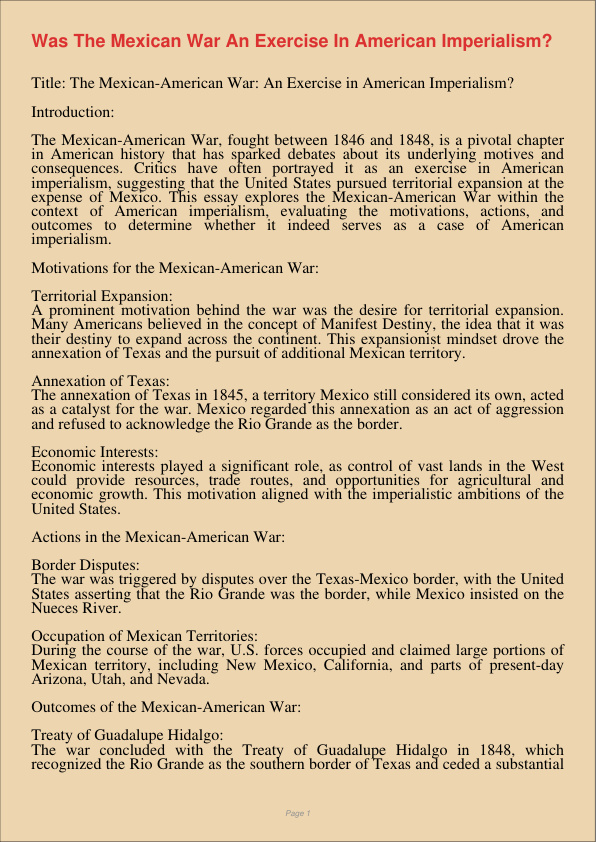Was The Mexican War An Exercise In American Imperialism
Jan 9, 2024
mexican war
american imperialism
Education
Law
Title: The Mexican-American War: An Exercise in American Imperialism?
Introduction:
The Mexican-American War, fought between 1846 and 1848, is a pivotal chapter in American history that has sparked debates about its underlying motives and consequences. Critics have often portrayed it as an exercise in American imperialism, suggesting that the United States pursued territorial expansion at the expense of Mexico. This essay explores the Mexican-American War within the context of American imperialism, evaluating the motivations, actions, and outcomes to determine whether it indeed serves as a case of American imperialism.
Motivations for the Mexican-American War:
Territorial Expansion: A prominent motivation behind the war was the desire for territorial expansion. Many Americans believed in the concept of Manifest Destiny, the idea that it was their destiny to expand across the continent. This expansionist mindset drove the annexation of Texas and the pursuit of additional Mexican territory.
Annexation of Texas: The annexation of Texas in 1845, a territory Mexico still considered its own, acted as a catalyst for the war. Mexico regarded this annexation as an act of aggression and refused to acknowledge the Rio Grande as the border.
Economic Interests: Economic interests played a significant role, as control of vast lands in the West could provide resources, trade routes, and opportunities for agricultural and economic growth. This motivation aligned with the imperialistic ambitions of the United States.
Actions in the Mexican-American War:
Border Disputes: The war was triggered by disputes over the Texas-Mexico border, with the United States asserting that the Rio Grande was the border, while Mexico insisted on the Nueces River.
Occupation of Mexican Territories: During the course of the war, U.S. forces occupied and claimed large portions of Mexican territory, including New Mexico, California, and parts of present-day Arizona, Utah, and Nevada.
Outcomes of the Mexican-American War:
Treaty of Guadalupe Hidalgo: The war concluded with the Treaty of Guadalupe Hidalgo in 1848, which recognized the Rio Grande as the southern border of Texas and ceded a substantial portion of Mexican territory to the United States for $15 million. This territory included modern-day California, Nevada, Utah, Arizona, New Mexico, and parts of Colorado, Wyoming, Kansas, and Oklahoma.
Imperialist Consequences: The acquisition of such vast territories through the Treaty of Guadalupe Hidalgo can be seen as an imperialistic outcome, as it expanded the U.S. domain significantly at Mexico’s expense.
Conclusion:
The Mexican-American War is indeed a complex and contentious chapter in American history, with arguments both for and against labeling it as an exercise in American imperialism. While the war had multiple motivations, including economic and territorial expansion, its ultimate consequence, the acquisition of vast Mexican territories, aligns with the characteristics of imperialism. Whether one labels it as imperialism or not, it is undeniable that the Mexican-American War had profound and lasting consequences, with far-reaching implications for the history and geography of the United States and Mexico.
